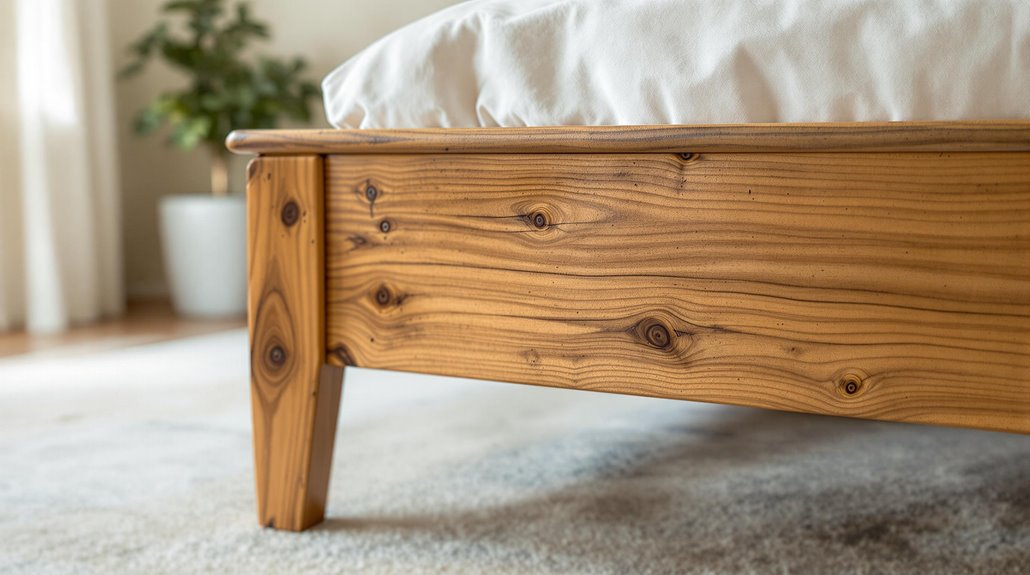Solid wood bed frames are known for their durability, especially when crafted from high-quality hardwoods such as oak or maple, which can last between 20 to 25 years with proper care. In contrast, softwoods typically have a lifespan of 5 to 10 years. The construction quality, including strong joints and support systems, greatly affects longevity; well-constructed frames can last even longer. Environmental factors, such as humidity and temperature, also play an essential role in wood integrity. Regular maintenance and attention to signs of wear can enhance their lifespan further, revealing important considerations for potential purchasers.
Types of Wood and Longevity
The choice of wood greatly influences the longevity of bed frames. Hardwoods, such as oak, cherry, maple, and walnut, typically last 20 to 25 years on average, offering durability and the ability to support considerable weight without bending. These high-quality materials considerably extend the lifespan of bed frames. In contrast, softwoods like cedar, spruce, and fir generally last only 5 to 10 years. While they are more affordable, they are also less durable and prone to wear. Engineered wood options, including MDF and chipboard, range from 5 to 8 years in lifespan, but they are more susceptible to moisture damage. Proper maintenance and environmental stability can further enhance wood longevity, underscoring the importance of wood choice in bed frame durability.
Impact of Construction Quality
Construction quality plays an essential role in determining the longevity and durability of solid wood bed frames. Well-built beds, featuring sturdy joints like mortise and tenon or dovetail joints, greatly enhance stability and longevity. A solid support system, which may include extra support bars or center support legs, helps distribute weight evenly, reducing stress on the frame. High-quality construction employs reinforced corners and meticulous craftsmanship, ensuring that the frame can withstand considerable weight without bending or deforming over time. The use of strong connections throughout the structure further extends the lifespan of the bed frame. Ultimately, investing in quality construction is vital for achieving a durable and long-lasting solid wood bed frame that can endure daily use.
Importance of Joint Types
Quality construction greatly influences the longevity of solid wood bed frames, and one of the key elements in this construction is the type of joints used. Joints such as mortise-and-tenon and dovetail are recognized for their high strength and durability, each adding approximately three years to the wood's lifespan. In contrast, dowel and biscuit joints offer medium strength but are less robust compared to the former options. Butt joints, when reinforced, provide low to medium strength, contributing an additional year. The choice of joint impacts not only the immediate stability of the frame but also its long-term durability. Regular maintenance and timely repairs of any joint damage are essential in preserving the integrity and lifespan of the bed frame.
Role of Slat Support
Slat support plays an essential role in the overall stability and durability of solid wood bed frames. The type of wood used for slats greatly impacts longevity; hardwoods like oak and maple provide superior strength compared to softwoods such as pine. Thicker, wider slats enhance weight distribution and reduce the risk of bending, extending the bed frame's lifespan. Additionally, a well-structured configuration, including vertical slats and a sturdy center beam, further reinforces support. Consistent maintenance, such as avoiding harsh chemicals and ensuring even weight distribution, is vital to prevent premature wear. By prioritizing high-quality materials and proper care, the slat support system can greatly influence the overall durability of the bed frame, ensuring longevity and stability.
Environmental Factors
While the aesthetic appeal of solid wood bed frames is undeniable, their longevity is largely influenced by environmental factors that can affect their structural integrity. Humidity changes can lead to warping or cracking, while moisture damage requires prompt attention to avoid further deterioration. Temperature fluctuations may compromise the wood's stability, and direct sunlight can cause fading and weakening. Additionally, pest infestations, particularly termites, necessitate periodic treatments to maintain the frame's integrity. Environments with high humidity or extreme dryness can accelerate wear, reducing the frame's lifespan. Conversely, a stable environment can enhance durability considerably. As a result, understanding and addressing these environmental factors is essential to maximizing the longevity of solid wood bed frames.
Maintenance Practices
Maintaining a solid wood bed frame requires a consistent cleaning routine and the application of protective treatments. Regular dusting and careful cleaning with appropriate solutions can prevent damage and preserve the wood's natural beauty, while periodic polishing enhances its protective finish. Additionally, implementing these maintenance practices not only extends the longevity of the bed frame but also guarantees it remains a functional and aesthetically pleasing piece of furniture.
Regular Cleaning Routine
A consistent cleaning routine is vital for preserving the longevity and aesthetic appeal of solid wood bed frames. Regular dusting with a soft cloth or microfiber duster removes loose dirt, while a damp cloth can effectively wipe down surfaces without excessive moisture. It is important to focus on hard-to-reach areas and intricate details, employing a bristle brush when necessary. Immediate attention to liquid spills can prevent damage, utilizing a clean cloth to absorb moisture. For tough stains, a mild detergent solution or vinegar-water mix should be tested on inconspicuous areas first. General cleaning involves removing bedding and using warm water with mild soap to guarantee a thorough clean, complemented by inspections to identify early signs of wear or damage.
Protective Treatments Application
Regular cleaning serves as the foundation for maintaining solid wood bed frames, but the application of protective treatments further enhances their durability and appearance. Utilizing natural oils, such as beeswax and linseed oil, minimizes volatile organic compounds (VOCs), promoting a safer environment. Water-based finishes with zero VOCs offer effective protection without toxic emissions, while avoiding harsh chemical varnishes and adhesives is vital for preserving wood integrity. Additionally, maintaining appropriate humidity levels prevents warping, and keeping the frame out of direct sunlight mitigates fading. Routine applications of furniture wax or polish every three to six months can bolster the wood's resilience. Regular inspections for scratches and structural issues, along with prompt attention to spills, are essential for prolonging the bed frame's lifespan.
Usage Patterns
Usage patterns greatly influence the longevity of solid wood bed frames, particularly when considering factors such as weight distribution and frequency of use. For instance, even weight distribution can extend the frame's lifespan, while heavy use, such as multiple users or children jumping, tends to accelerate wear. Additionally, proper care practices, including rotating the mattress and minimizing strenuous activities on the bed, can further enhance durability and performance over time.
Heavy Use Impact
While heavy use patterns can markedly influence the longevity of solid wood bed frames, the type of wood and construction quality play critical roles in determining durability. Hardwoods such as oak and maple outperform softwoods like pine under frequent use, lasting up to 20-25 years compared to just 5-10 years for softer varieties. The density of the wood considerably affects its resistance to wear, while construction methods, including mortise and tenon joints, enhance stability. Thick, solid slats distribute weight effectively, further extending the frame's lifespan. In environments with shared or commercial use, additional support and reinforcement are crucial. As a result, understanding these factors is essential for ensuring the longevity of a solid wood bed frame in heavy use scenarios.
Proper Care Practices
Maintaining the longevity of solid wood bed frames requires diligent care practices tailored to their usage patterns. Regular cleaning with a soft cloth prevents dust accumulation, while avoiding harsh chemicals safeguards the wood's integrity. To protect and enhance appearance, applying furniture wax or polish is advisable. Addressing spills promptly is crucial to prevent potential damage. Additionally, keeping the bed frame away from direct sunlight minimizes fading and cracking.
Regular checks on hardware integrity, including tightening screws and inspecting joints, guarantee stability. Environmental conditions should be stable, avoiding excessive humidity fluctuations and extreme temperatures. Proper weight distribution is imperative; using adequate support systems like thicker slats or box springs can prolong the frame's life considerably by preventing structural stress.
Weight Capacity Considerations
Weight capacity is an important consideration when selecting a solid wood bed frame, as it directly influences both functionality and durability. The type of wood used plays a significant role; hardwoods like oak and maple offer greater support compared to softer woods such as pine. Additionally, frames that incorporate steel reinforcements or advanced construction techniques, like mortise and tenon joints, enhance overall stability and weight capacity. Support systems, including solid wooden slats and central beam supports, are vital for effectively distributing weight. Adhering to manufacturer weight guidelines is necessary to prevent premature wear. Regular inspections and maintenance can further extend the frame's lifespan and guarantee it can consistently bear the intended load, preserving its structural integrity over time.
General Lifespan Expectations
Longevity is an essential aspect to evaluate when investing in a solid wood bed frame, as it directly impacts both value and satisfaction over time. High-quality hardwoods, such as oak or maple, can last between 20 to 25 years, while softwoods typically endure 5 to 10 years. The construction quality also plays a significant role; utilizing dovetail or mortise and tenon joints can add three years to the frame's lifespan. Additionally, the type of slats used contributes to durability, with thicker and vertical slats enhancing longevity. Maintaining a stable environment and regular upkeep can further extend the lifespan by up to four years. Conversely, poor conditions may reduce it by three years, underscoring the importance of proper maintenance.
Signs for Replacement
Recognizing the signs that indicate the need for a replacement of your solid wood bed frame is essential for maintaining ideal sleep quality and safety. Creaking noises often signal a deterioration in structural integrity, while visible damage such as cracks or sagging in the mattress suggests inadequate support. Additionally, any noticeable signs of wear in the frame's hardware can compromise stability, warranting immediate attention to prevent further issues.
Creaking Noises
Creaking noises emanating from a solid wood bed frame can signal underlying issues that may necessitate replacement. These sounds often indicate wear at the joints or a weakening of the wood, typically resulting from loosened screws or bolts over time. Persistent creaking suggests that the frame's structural integrity is compromised, ultimately affecting its ability to provide adequate support. While tightening screws may offer a temporary solution, it does not address the root cause of deterioration. Additionally, such noises can disrupt sleep quality, making it difficult to rest comfortably. As a result, if a bed frame consistently creaks, it may be prudent to reflect on a replacement, even if other components, such as the mattress, remain in good condition.
Visible Damage
A solid wood bed frame's lifespan can be considerably impacted by visible damage, which serves as a clear indicator that replacement may be necessary. Cracks and splits undermine structural integrity, potentially compromising the frame's ability to support the mattress. Such defects can worsen over time, leading to further deterioration and safety concerns. Additionally, chipping and erosion expose the wood to moisture, weakening the frame and requiring prompt attention. Loose fittings or hardware signal instability, necessitating immediate adjustment or replacement to guarantee supportive capacity. Finally, discoloration or stains may indicate moisture damage or rot, warranting thorough inspection and maintenance. Addressing these visible damages proactively is essential to maintaining both safety and comfort in your sleeping environment.
Sagging Mattress Support
Sagging mattress support is a crucial issue that can greatly affect both comfort and sleep quality. Signs of inadequate support include creaking or splintering bed frames and broken or warped slats. Such defects compromise the stability of the mattress, leading to premature sagging and uneven spinal alignment, which may result in discomfort and pain. Additionally, slats spaced more than three inches apart can exacerbate this problem, particularly for foam mattresses. Regular inspections are essential; broken slats should be replaced, and additional slats may be necessary for ideal support. If the box spring exceeds seven years of use, consider replacement alongside the mattress. Ensuring a solid foundation is imperative for maintaining mattress performance and longevity.

